
Top 25 Rankings 1901-1935
1909 National Championship
Home
1909
College Football Top 25
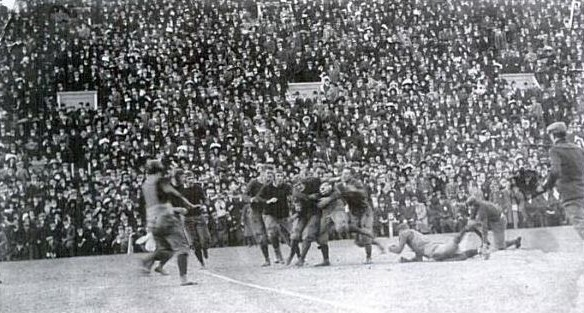
9-0 Yale
traveled to 8-0 Harvard to finish the 1909 season and decide the
mythical national championship (pictured above). Harvard doubled Yale's
offensive yards, but Yale killed them in the kicking game and won 8-0
on a pair of field goals and a blocked punt for a safety. I summarized 10-0 Yale and their season
in my 1909 national
championship article. They would have been a landslide #1 in a 1909 AP poll, and 8-1 Harvard a landslide #2.
Yale #1, Harvard #2.
Notre Dame,
Michigan, and Minnesota
What
a huge year this was for Notre Dame, and for the "West" in general.
1913 is often cited as Notre Dame's breakthrough season, because they
defeated Eastern power Army that year, and thereby introduced
themselves to Eastern football writers. But 1909 gave Notre Dame its
first victory over Michigan (6-1, #4), after 8 failed tries, and that
11-3 win gave Notre Dame the unofficial title "Champions of the West."
Notre Dame also won 6-0 at 6-2-1 Pittsburgh (will be rated #13) and
17-0 over 8-1 Michigan State (#18), but they were tripped up by a
scoreless tie in their finale at Marquette (2-2-1, #20) on Thanksgiving
Day, finishing them at 7-0-1. Marquette's losses came to Michigan (by
just 1 point!) and Michigan State.
It's quite possible that Michigan would have been rated higher than
Notre Dame in a 1909 AP poll, and their coach Fielding Yost was adamant
that his team was better, declaring Michigan the real "Champions of the
West." More on that below. Some football writers agreed that Michigan
was better, as they pulled off a couple of huge wins against the
vaunted East: 44-0 over 4-5-1
Syracuse and 12-6 at 7-1-2 Pennsylvania. The Syracuse score was often
cited by writers in the West as a reason to think that Notre Dame or
Michigan was the true "national champion," because Yale only beat
Syracuse 15-0. The win over Penn was Michigan's first, after 3 straight
losses 1906-1908.
These 2 Michigan wins, along with Notre Dame's
win at Pitt, represented a sea change. In all, major teams
from the West were 4-0-1 against major teams from the East, the first
year the West ever outdid the East. And the West would continue to post
winning records against the East over the next several seasons.
But Michigan had other big wins:
3-0 over 6-1-2 Case, 6-5 at 2-2-1 Marquette (#20), and 15-6 at 6-1
Minnesota (#5) in their finale. This was Michigan's first time playing
Minnesota for the "Little Brown Jug," which Michigan took home with
them after the game. Because of all these impressive wins, but
particularly those over 6-1 Minnesota and 7-1-2 Penn, there was some
reason to believe that Michigan was better than Notre Dame. But Notre
Dame didn't just beat Michigan, they defeated 2 other rated teams, and
their head-to-head win over Michigan, won by more than a touchdown and
in Ann Arbor, outweighs their upset tie to Marquette. So Notre Dame
deserves and will get slot #3 in this top 25. They were the football season's
biggest surprise by far.
Michigan
will have to settle for #4, earned by those wins at Penn and Minnesota.
6-1 Minnesota, I believe, would have been rated #5 in an AP poll.
Although they did not beat any top 25 teams, they had rolled up
impressive scores over every opponent before their finale against
Michigan, and they gave a couple of teams their only loss, 20-6 over
4-1-2 Chicago and 34-6 at 3-1-1 Wisconsin (both will fall just outside the top 25).
Notre Dame #3, Michigan #4, and Minnesota #5.
Notre Dame
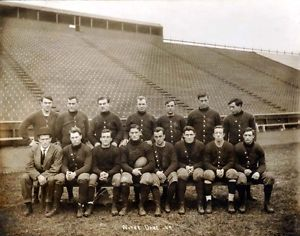
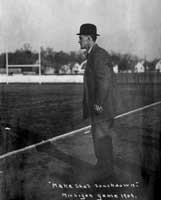 Notre
Dame had first started consistently winning in 1906, going 6-1 that
season and
6-0-1 the next, but they were a minor team playing mostly minor teams.
In 1908, they added Michigan, the region's biggest team, to their
schedule and lost just 12-6, finishing 8-1. Frank "Shorty" Longman
(pictured at the 1909 Michigan game), who had played at Michigan
1903-1905 and still lived in Ann Arbor, took over as coach this season.
He had been a meager 8-13-3 at Arkansas and Wooster the previous 3
years, but at Notre Dame he went 7-0-1 this year and 4-1-1 the next,
after which he retired from coaching. His one great achievement was
directing Notre Dame's first-ever win over Michigan this season.
Notre
Dame had first started consistently winning in 1906, going 6-1 that
season and
6-0-1 the next, but they were a minor team playing mostly minor teams.
In 1908, they added Michigan, the region's biggest team, to their
schedule and lost just 12-6, finishing 8-1. Frank "Shorty" Longman
(pictured at the 1909 Michigan game), who had played at Michigan
1903-1905 and still lived in Ann Arbor, took over as coach this season.
He had been a meager 8-13-3 at Arkansas and Wooster the previous 3
years, but at Notre Dame he went 7-0-1 this year and 4-1-1 the next,
after which he retired from coaching. His one great achievement was
directing Notre Dame's first-ever win over Michigan this season.
Shorty
Longman's former coach at Michigan, Fielding Yost, did not take their
loss to Notre Dame well at all, and by the end of the season he had
proclaimed
his team the "Champions of the West" anyway. One reason he gave was
that Notre Dame had only been scheduled to provide practice for the
"real" games to come:
"You must recognize the fact that we went into the game caring little
whether we won or lost." This excuse is amusing in light of what he had
said right after the game:
"What makes me so dog-goned mad is that we might have won. Those are
the worst kind of games to lose. They leave a worm in the heart to gnaw
and gnaw." And indeed, this was a loss that would gnaw at his heart for
decades.
Another reason Yost gave for why his team was the
"true" Champion of the West was Notre Dame's loose eligibility
standards for players. This excuse is also amusing, because as it
turned out, it was
Michigan that had been using an ineligible player, as it was discovered
in December
that their captain, J. Joy Miller, had not attended a single class that
Fall. Michigan at first offered to forfeit all their games, then
decided instead to send letters of apology to all of their 1909
opponents.
Shorty Longman spent the entire off-season bragging about his
team's 11-3 win over Michigan all over Ann Arbor, and that planted in Fielding Yost a deep and undying hatred for
Notre Dame. On the eve of their 1910 game, Michigan canceled it, and
they refused to play Notre Dame again until a 2-year series during
World War 2, and not again after that until 1978. Yost tirelessly
worked to keep Notre Dame out of the Big 10, and to convince other
conference teams not to play them, hoping that Notre Dame's football program
would wither and die. Obviously he failed in that regard.
This year's Notre Dame team featured 4 All-Western players:
fullback Robert Vaughan and linemen Sam Dolan, George Philbrook, and
Ralph Dimmick. Vaughan was the line plunger around whom the whole
offense was built, and a big reason Notre Dame was tied by Marquette in
their finale is that Vaughan was out of the lineup that day. Sam Dolan,
on the other hand, played every minute of every game this season,
toughing out a shoulder injury in that Marquette game. He was great on
defense, a linebacker who was in on every tackle. Vaughan would become
a longtime head coach at Wabash, going 115-85-24 there 1919-1945.
Halfback
Harry "Red" Miller did not make first-team All Western (he was 2nd
team), but he was the only one from this team to make Walter Camp's All
American list, albeit as a 3rd team selection.
Pennsylvania, Lafayette, Princeton, and Dartmouth
I think 7-1-2
Pennsylvania would have been rated next, but we're going to go with
7-0-1 Lafayette instead. These teams tied each other in a game played
at Penn, but Penn also took a tie to a lower-rated team, 5-0-2 Penn
State, and Lafayette was not upset. And Lafayette won 6-0 at 6-2-1
Princeton the week before they tied Penn, a better win than any by Penn.
Penn's loss came 12-6 to #4 Michigan at home. They won 22-0 over
6-1-1 Ursinus (#26-33), 13-5 over 7-3 Brown (#10), and 29-6 over 8-3-1
Carlisle (#14).
In addition to Lafayette, 6-2-1 Princeton lost
17-0 at #1 Yale. Their tie came to 5-1-2 Dartmouth. Penn
gets a higher rating than Princeton because they tied Lafayette, and
Princeton lost to them.
5-1-2 Dartmouth took their loss 12-3 at #2 Harvard. In addition to
Princeton, they tied a bad 4-2-2 Vermont team, which is what keeps them
rated behind Princeton. Dartmouth's wins all came by more than a
touchdown, the best being 18-0 over 5-2 Williams (#26-33).
Lafayette #6, Pennsylvania #7, Princeton #8, and Dartmouth #9.
Lafayette
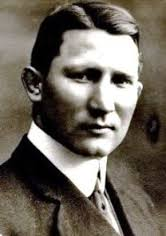
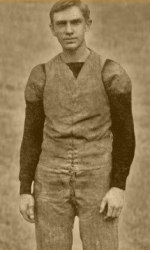 This
was the first year in the career of one of the greatest and most
underrated football coaches of all time, Bob Folwell (pictured above).
He had played halfback for Penn 1904-1907, and he went 22-4-1 as head
coach at Lafayette 1909-1911. After that he went 36-5-3 at Washington
& Jefferson 1912-1915, 27-10-2 at his alma mater 1916-1919, and
24-12-3 at Navy 1920-1924. His teams were top 25 caliber in all of his
first 15 seasons as a coach, and overall he was 109-31-9, which puts
him on the list for best all-time coaching win percentage.
He is one of the 2 most glaring omissions on the part of the Hall of
Fame, the other being this year's coach of Texas A&M (covered
below).
This
was the first year in the career of one of the greatest and most
underrated football coaches of all time, Bob Folwell (pictured above).
He had played halfback for Penn 1904-1907, and he went 22-4-1 as head
coach at Lafayette 1909-1911. After that he went 36-5-3 at Washington
& Jefferson 1912-1915, 27-10-2 at his alma mater 1916-1919, and
24-12-3 at Navy 1920-1924. His teams were top 25 caliber in all of his
first 15 seasons as a coach, and overall he was 109-31-9, which puts
him on the list for best all-time coaching win percentage.
He is one of the 2 most glaring omissions on the part of the Hall of
Fame, the other being this year's coach of Texas A&M (covered
below).
The star of this year's Lafayette team was fullback George McCaa
(pictured at left), who was great on both offense and defense, and also
as a punter and kicker. Walter Camp selected him as a 3rd team All
American in 1908 and 1909. He scored 36 touchdowns in his career.
McCaa figured prominently in Lafayette's 2 biggest games this year,
as did substitute halfback Frank Irmschler. The first big game, at #8
Princeton, was scoreless as Princeton lined up to kick a short field
goal in the game's closing seconds. McCaa directed Irmschler to move to
a different spot on the line at the last moment before the snap, hoping
to catch Princeton with not enough blockers there, and it worked.
Irmschler came through unimpeded and blocked the field goal. The ball
bounced off his thigh and into his arms, so he ended up catching it on
the fly, and he ran it back 85 yards for a touchdown and a miraculous
6-0 win on the last play of the game. This was Lafayette's first-ever
win over Princeton.
The other big game was at #7 Penn the next
week. This game was also scoreless through the first half, but
Lafayette got on the board first with a touchdown pass from McCaa to
Irmschler. Penn's starters could get nowhere, so the substitutes were
sent in for about the last 10 minutes of the game, and their fresh legs started
moving the ball on Lafayette, who was not as deep and could not
substitute quality players as easily. Penn finally scored a touchdown
in the game's last minute, so the teams tied 6-6.
Brown, Penn State, and Army
I'm thinking
that 7-3 Brown, 5-0-2 Penn State, and 3-2 Army would have been rated next, in
that order. I would rate Brown higher than Dartmouth myself, but I let
the hypothetical AP poll voters of 1909 have this one, since Brown had
a weak performance against a bad Rhode Island team, they got routed
23-0 by #1 Yale, and they lost to #2 Harvard worse than Dartmouth did.
Brown's other loss came 13-5 at #7 Penn. Their one big win came 21-8
over 8-3-1 Carlisle (#14).
5-0-2 Penn State took their ties to #7 Penn and #14 Carlisle, so
one higher-ranked team and one lower. Their one big win came 5-0 at #13
Pittsburgh.
3-2 Army cut their season short due to the death of a player (more
on that below). Their losses came to #1 Yale and #2 Harvard. Neither
loss was close, and Army didn't beat a good team, so any rating for
them is largely conjecture, or an extrapolation based on where they'd
been ranked in previous seasons. Still, there's no problem rating them ahead of Pitt
(who will be ranked next), because Pitt was tied by a bad 4-3-2 West
Virginia team.
Brown #10, Penn State #11, and Army #12.
Army
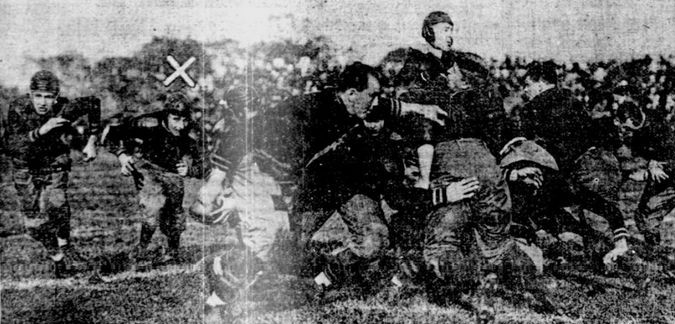
The
player who lost his life was Army tackle Eugene Byrne. His spine was
snapped as he tried to make a tackle in a game against Harvard, and he
was paralyzed. The photo above was taken seconds before the tragedy
happened, and Byrne is marked with an "X." The game was ended after
Byrne's injury, with 10 minutes to go, and Harvard was declared the
winner by a score of 9-0. Byrne died the next morning, and
Army canceled the rest of their season.
Byrne was just the
most famous example this year of an epidemic. 26 people were killed
playing football in 1909, and 70 seriously injured. A Virginia halfback
was killed in a game at Georgetown, and both teams canceled the rest of
their seasons. A Navy quarterback was paralyzed due to an injury in a
game, and would die the following Spring. All these deaths led to more
rules changes, much like in 1905. Seven men had to be on the line of
scrimmage from now on, so that linemen wouldn't get running starts
before their collisions, and players could no longer push or pull ball
carriers forward.
Pittsburgh, Carlisle, Virginia Tech, and Washington & Jefferson
6-2-1 Pittsburgh
took their losses to #3 Notre Dame and #11 Penn State. As previously noted, they
tied a bad 4-3-2 West Virginia team, but they had a pair of big wins,
14-3 over 8-3-1 Carlisle and 17-3 over 8-1-1 Washington & Jefferson.
In addition to Pitt, 8-3-1 Carlisle lost to #7 Penn and #10 Brown.
Their tie came against a higher-rated team, #11 Penn State. Their best
win came 9-0 over 3-2 Villanova (#26-33), but it's the tie with Penn
State that gets them ranked ahead of Virginia Tech.
6-1 Virginia
Tech lost just 8-6 at #8 Princeton. They won 6-0 over 6-3 Clemson, 15-0
over 5-2 North Carolina, and most importantly, 18-5 over 6-1 North
Carolina State (#23).
As noted, 8-1-1 Washington & Jefferson took their loss to #13
Pitt. Their tie came 0-0 at 4-3-1 Navy (unrated), and that's what gives
Virginia Tech a higher rating. Washington & Jefferson did not
defeat a good team, so this rating may be higher than they deserve, but
it's about where an AP poll would have ranked them, and it'll work well
enough.
Pittsburgh #13, Carlisle #14, Virginia Tech #15, and Washington & Jefferson #16.
Virginia Tech
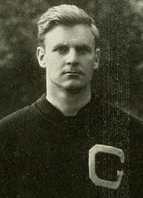
Virginia Tech was known at this time as VPI, Virginia Polytechnic
Institute, and they were called the "Gobblers" rather than the Hokies.
The head coach was Branch Bocock (pictured), who had been a quarterback
at Georgetown 1903-1906. He coached all over the South, never hanging
around in one place very long. He went 12-3 at Virginia Tech 1909-1910,
then 6-1-1 at North Carolina in 1911, then 22-11-2 back here at
Virginia Tech again 1912-1915, the longest stint of his coaching
career. Overall he was 98-55-9 in 19 seasons at 6 schools, the others
being Georgia, LSU, South Carolina, and William & Mary.
Two
Virginia Tech players were All-Southern this year, end J. T. Luttrell
and guard E. F. "Hoss" Hodgson. Virginia Tech was oh-so-close to
upsetting Princeton and thereby finishing with a perfect record this
season. In the first minute of play in that game, Princeton returned a
fumble for a touchdown, but missed the extra point, so it was 5-0.
Later, Virginia Tech turned the same trick, Hoss Hodgson returning a
fumble 50 yards for a touchdown. Hodgson kicked the extra point
for a 6-5 lead that held up until late in the game, when Princeton
kicked a 38 yard field goal for an 8-6 win.
Washington,
Michigan State, Sewanee, and Marquette
Token
team time,
and we've reached the point in the top 25 where it's mostly just
guesswork as far as estimating where a 1909 AP poll would have rated
these teams. My first guess is 7-0 Washington, champion of the
Northwest and unbeaten for the 2nd straight season. How good the
Northwest was compared to the rest of the country, we'll never know.
Next
we'll go with 8-1 Michigan State, who was considered a mid-major type
team at this time (at best). They lost 17-0 at #3 Notre Dame. Their
best win came 10-0 over 2-2-1 Marquette (will be rated #20). #3 Notre
Dame was tied by Marquette, and Michigan only beat them 6-5. The rest
of Michigan State's wins were routs.
Then
we've got 6-1 Sewanee, who took their loss 20-0 at #8 Princeton. They
did not defeat a rated opponent, but they did
defeat a bunch of winning teams: 6-2 Louisiana State (#26-33), 7-2 Georgia Tech, 5-2 Auburn, and 7-3 Vanderbilt.
2-2-1 Marquette had a better relevant record than Sewanee did,
thanks to their tie with #3 Notre Dame, but that and a close loss to #4
Michigan are all Marquette accomplished, so I think Sewanee, who
defeated 4 winning major teams, can be ranked ahead of Marquette.
Washington #17, Michigan State #18, Sewanee #19, and Marquette #20.
Sewanee
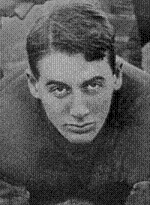
Sewanee
is what people like to call the University of the South, after the town
where the school is located. There was a time, specifically 1898-1912,
when Sewanee was a power team in the South. The head coach, in his
first season this year, was Sewanee grad Harris Cope. He went 43-18-7
here 1909-1916. This season was the last time Sewanee fielded a top 25
caliber team.
Sewanee fielded 5 players who were All-Southern, and they had one player who is in the Hall of Fame:
center/linebacker Frank Juhan (pictured). He eventually became a
bishop in the Episcopal Church, and Sewanee's basketball gym is named
for him.
Marquette
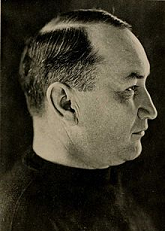
This
was Marquette's first top 25 caliber team. Their last was 1936, when
they were ranked #20 in the AP poll (dropping to #24 in the fixed AP
poll). Marquette, known as the Golden Avalanche at this time, got a lot
of attention in the press this year, first for losing to Michigan by
just 1 point in October, and then by tying Western Champion Notre Dame
on Thanksgiving Day. It was also a big year for Marquette because in
1909 they became the first coed Catholic university in the world.
The
coach was Bill Juneau (pictured), a Wisconsin grad who went 19-5-6 at
Marquette 1908-1911. He then went 18-8-2 at his alma mater 1912-1915,
the highlight a 7-0 finish in 1912 that
was very close to being MNC-worthy. After that he went 19-7 at Texas
1917-1919, with another perfect season (9-0) in 1918. Overall he was a
strong 86-39-12 at 6 schools.
This Marquette team became famous not just
because they lost to mighty Michigan by a mere extra point, but because
they outplayed Michigan in that game. Michigan recovered 3 onside punts
(legal in those days) deep in Marquette territory, and the third time
they were able to score. Marquette also scored a touchdown, but they
missed the extra point, so they were still down 6-5 at the half. The
2nd half was played almost entirely on Michigan's side of the field,
but Marquette could not score, so Michigan held on for the win in a
game where they produced almost no offense.
Arkansas, Colorado, North Carolina State, and Kentucky
7-0
Arkansas got their best win 16-0 over 6-2 Louisiana State in Memphis. 6-0 Colorado won 9-0 at 5-2
Colorado College. Since Colorado only won 3-0 over a high school team,
we'll rank Arkansas higher.
6-1 North Carolina State, then known as North Carolina A&M, took their loss 18-5 at #15 Virginia Tech.
Their biggest win came 15-6 over 9-1 Kentucky. Kentucky's biggest win
came 6-2 at 5-2 Illinois.
Arkansas #21, Colorado #22, North Carolina State #23, and Kentucky #24. North Carolina State's head coach
was Eddie Greene, who, like Lafayette coach Bob Folwell, had played
halfback for Penn 1904-1907. His coaching career was brief but
successful, 25-8-2 at NC State 1909-1913 with 2 SIAA titles.
Arkansas
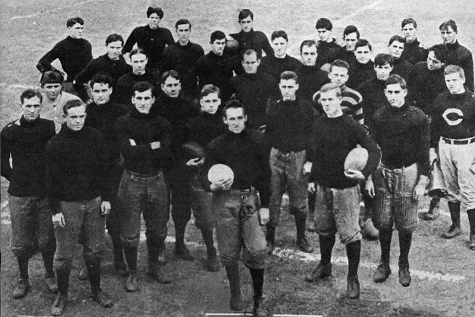
This
is the first time Arkansas fielded a top 25 caliber team. They wouldn't
field another until 1936, when they appeared in the first AP poll.
Their coach was Hall of Famer Hugo Bezdek (wearing the Chicago sweater
in the team picture, on the right), who had been born in Prague, and
had been the fullback on Chicago's 1905
national championship team. He coached one year at Oregon in 1906,
going 5-0-1, and then he went 29-13-1 at Arkansas 1908-1912. He
returned to Oregon 1913-1917, going 25-10-3 and winning a Rose Bowl,
then he won another Rose Bowl as coach of the Mare Island marines
during World War 1. He spent the next 12 years as coach of Penn State,
going 65-30-11, winning an MNC in 1919
and taking a third team to the Rose Bowl following the 1922 season.
Overall he was 127-58-16. He later became the only man who has coached
an NFL team and managed a major league baseball team.
As
indicated above, the big win for Arkansas this season came
16-0 over LSU in Memphis. Fans gathered around the Western Union
office in Fayetteville getting updates on the game via telegraph. When
the team returned, a crowd greeted them at the train station. Hugo
Bezdek told the crowd that his team had played "like a wild band of
razorback hogs," and that is how the school's athletic teams got their
name.
Hugo Bezdek convinced his old coach, the venerable Amos Alonzo
Stagg, whose team Chicago had already completed their season, to come down to
Little Rock and referee a game between Arkansas and Washington
(Missouri) on Thanksgiving Day. That helped Arkansas receive some press
outside of their region.
Kentucky
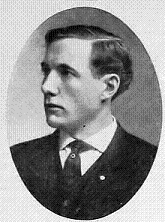
1909
Kentucky's story is very similar to that of 1909 Arkansas. This was the
first time Kentucky fielded a top 25 caliber team, and they wouldn't
field another until 1939, when they make the fixed and expanded AP poll
top 25 (they wouldn't be rated by an actual AP poll until 1949). The
coach was Edwin Sweetland (pictured), a Cornell grad who had been very
successful coaching Syracuse 1900-1902, going 20-5-2. After stops at
Ohio State and Colgate, he came to Kentucky for a couple of years
1909-1910 and went 16-3. He came back to Kentucky for a one-year encore
in 1912 and went 7-2. Overall he was 100-41-10 at 9 schools.
Kentucky's
big win, again, was the 6-2 victory at Illinois, a very rare instance
of a Southern team beating a Western Conference (Big 10) team. Now
here's the part that is particularly similar to the story of 1909
Arkansas: the day after the
Illinois win, a school official who had attended the game told students
during a chapel service that the team had "fought with the ferocity of
mountain wildcats," and that is how the athletic teams at Kentucky got
their name. It should be noted that Illinois held key players out of
the Kentucky game so they'd be fresh for the far bigger Chicago game
the next week, but a win is a win, and this one was huge for Kentucky
regardless.
Missouri and Texas A&M
Last
slot, and I'm going to make things easy on myself and place our last 2 token teams into a tie with one another here.
7-0-1 Missouri was tied by 4-3-1 Iowa State. They had 4 close wins over
bad teams, but they also had 2 big wins, 12-6 over archrival 8-1
Kansas (#26-33) and 22-6 over 7-1 Drake (#26-33).
7-0-1 Texas A&M was tied by 5-2-1 Texas Christian. Their best win came 15-0 over 7-2 Haskell.
Missouri and Texas A&M are tied for #25.
Missouri
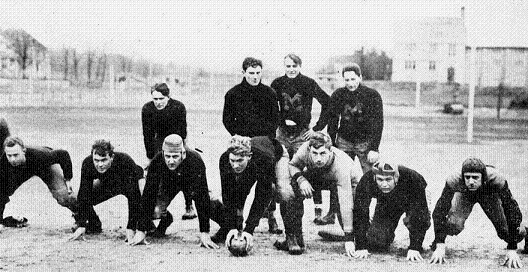
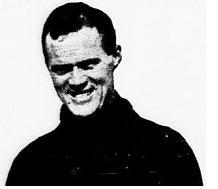 Missouri's
coach was Hall of Famer Bill Roper (pictured at left), a Princeton
graduate that mostly coached at his alma mater, but dropped by Columbia
to help Missouri out this one season. And it was a good one, 7-0-1 and
a Missouri Valley Conference championship. At Princeton he won 4
school-claimed MNCs (I recognize 2 of them, 1906 and 1922) and went 89-28-16 over 17 seasons. Overall he was 112-38-18 at 4 schools.
Missouri's
coach was Hall of Famer Bill Roper (pictured at left), a Princeton
graduate that mostly coached at his alma mater, but dropped by Columbia
to help Missouri out this one season. And it was a good one, 7-0-1 and
a Missouri Valley Conference championship. At Princeton he won 4
school-claimed MNCs (I recognize 2 of them, 1906 and 1922) and went 89-28-16 over 17 seasons. Overall he was 112-38-18 at 4 schools.
The season finale was the big rivalry game against Kansas on
Thanksgiving Day. The game was held in Kansas City, as it almost always
was 1891-1910. Both teams were undefeated. Kansas' star player,
quarterback Tommy Johnson, was injured in the first half, suffering
from what we now know to be a concussion. His teammates could not
understand him, and he could not remember which plays he'd called, but
his coach wouldn't take him out. Still, he played well enough that
Missouri only won 12-6. Missouri fans rushed the field and tore
down the goalposts, and that night they built a bonfire in the
street in front of the Kansas contingent's hotel, and burned a turkey
in it that they labeled "Jayhawk."
Perhaps they got a little
carried away, but this sort of thing didn't happen often. This was only
Missouri's 4th win against Kansas in 19 games, and they hadn't beaten
the Jayhawks since 1901. Kansas had not lost a game to anyone since
1907.
Texas A&M
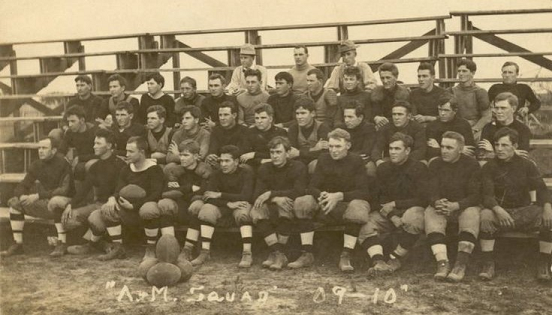
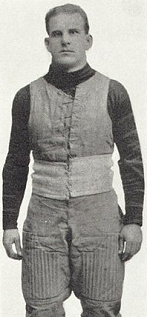 Texas
A&M was coached by the Hall of Fame's single greatest
omission, Charlie Moran (pictured at left). He played professional
baseball, mostly in the minors, 1902-1913, and in the Fall he coached
college football. He had been an assistant under Pop Warner at
Carlisle, and by 1909 he was an assistant at Texas A&M. But after
the team was tied by Texas Christian in their 2nd game, head coach N.
A. Merriam, who had gone 3-5 the year before, was sent packing, and
Charlie Moran took over as head coach. He proceeded to go 37-8-3 here
1909-1914, and 3-1 against Texas.
Texas
A&M was coached by the Hall of Fame's single greatest
omission, Charlie Moran (pictured at left). He played professional
baseball, mostly in the minors, 1902-1913, and in the Fall he coached
college football. He had been an assistant under Pop Warner at
Carlisle, and by 1909 he was an assistant at Texas A&M. But after
the team was tied by Texas Christian in their 2nd game, head coach N.
A. Merriam, who had gone 3-5 the year before, was sent packing, and
Charlie Moran took over as head coach. He proceeded to go 37-8-3 here
1909-1914, and 3-1 against Texas.
After that, Moran performed
one of the greatest coaching jobs of all time in turning little Centre
into a football power, going an incredible 53-6-1 there 1917-1923,
including a 9-0 MNC contender in 1919. Overall Moran was 131-35-11 at 4 schools, which places him on the list for best all-time coaching win percentage
(for details on how I compiled his career record, see the footnotes at
the bottom of the linked list). Charlie Moran was also a baseball
umpire 1918-1939, working 4 World Series.
The key player for Texas A&M this season was quarterback Victor
Kelley. He had played for Texas A&M in 1907, then went to Carlisle
and was a backup quarterback there in 1908. He came back to Texas
A&M this season, bringing with him Carlisle's starting
quarterback, Mike Balenti, and assistant coach Charlie Moran. When head
coach Merriam would not play Kelley in the tie against TCU, Texas
A&M students raised enough money to buy out Merriam's contract, and
Charlie Moran took over (which may have been the plan all along).
Kelley was installed at quarterback, and Balenti at halfback. A Balenti
field goal beat Baylor 9-6.
Texas
A&M played Texas twice this season. The first game was November 8th
in Houston, and Texas A&M won easily, 23-0. It was only their 2nd
win over Texas in 17 tries, and A&M students celebrated by building
the first Texas game bonfire, which would become a hallowed tradition
at the school. The rematch was the season finale and was played in
Austin on Thanksgiving Day. Victor Kelley scored A&M's only
touchdown, and the Aggies held off Texas with 5 goal line stands to
make that touchdown good for a 5-0 win.
Others
Receiving Votes
Here
are the teams closest to making this top 25. 5-0 North Dakota and 4-0 Howard
were too far removed from big time
football to consider.
Drake 7-1
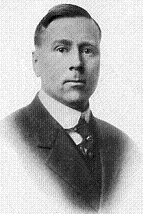
7-1 Drake took
their loss 22-6 at #25 Missouri. They did not beat a good team, but
they performed well, and only one of their wins was close.
This is the closest Drake ever got to top 25 caliber. Their coach
was John Griffith (pictured), a Beloit graduate who went 13-6-4 in 3
seasons at Morningside, then 36-25-3 at Drake 1908-1915. He was also
the athletic director, and he created the Drake Relays in 1910. The
school's name for its athletic teams, Bulldogs, originated with
Griffith's 2 bulldogs that students walked around the field during
games. Griffith later became the Big 10 Commissioner 1922-1944.
Kansas 8-1
8-1 Kansas took their loss 12-6 to #25 Missouri on a neutral field. They did not beat a good team, and they had 2 close wins.
Chicago 4-1-2
4-1-2 Chicago lost 20-6 to #5 Minnesota, and they tied 3-1-1 Wisconsin
(covered next) and 3-4-1 Cornell. Their best win was 14-8 over 5-2
Illinois.
Wisconsin 3-1-1
3-1-1 Wisconsin lost 34-6 to #5 Minnesota, and they tied Chicago (covered above). They did not beat a good team.
Villanova 3-2
3-2 Villanova took their losses to #8 Princeton and #14 Carlisle. They won 11-6 at 4-3-1 Navy.
Williams 5-2
5-2 Williams
took their losses to #2 Harvard and #9 Dartmouth. They did not beat a
particularly good team, but they won 3-0 at 3-4-1 Cornell, worth noting
since 4-1-2 Chicago tied Cornell.
Ursinus 6-1-1
6-1-1 Ursinus
took their loss to #7 Penn, and they were tied by a bad 4-3-2 Lehigh
team. They did not beat a good opponent, but their wins all came by big
scores.
Louisiana State 6-2
6-2
Louisiana State took their losses 15-6 to #19 Sewanee and 16-0 to #21
Arkansas. Their best win was 12-6 over 5-1-2 Alabama in their finale.
1909
Top 25
1)
Yale 10-0
2) Harvard 8-1
3) Notre Dame 7-0-1
4) Michigan 6-1
5) Minnesota 6-1
6) Lafayette 7-0-1
7) Pennsylvania 7-1-2
8) Princeton 6-2-1
9) Dartmouth 5-1-2
10) Brown 7-3
11)
Penn State 5-0-2
12) Army 3-2
13) Pittsburgh 6-2-1
14) Carlisle 8-3-1
15)
Virginia Tech 6-1
16) Washington & Jefferson 8-1-1
17) Washington 7-0
18) Michigan State 8-1
19) Sewanee 6-1
20) Marquette 2-2-1
21) Arkansas 7-0
22) Colorado 6-0
23) North Carolina State 6-1
24) Kentucky 9-1
25) Missouri 7-0-1
Texas A&M 7-0-1
Others
Receiving Votes:
Drake 7-1
Kansas 8-1
Chicago 4-1-2
Wisconsin 3-1-1
Villanova 3-2
Williams 5-2
Ursinus 6-1-1
Louisiana State 6-2




 Notre
Dame had first started consistently winning in 1906, going 6-1 that
season and
6-0-1 the next, but they were a minor team playing mostly minor teams.
In 1908, they added Michigan, the region's biggest team, to their
schedule and lost just 12-6, finishing 8-1. Frank "Shorty" Longman
(pictured at the 1909 Michigan game), who had played at Michigan
1903-1905 and still lived in Ann Arbor, took over as coach this season.
He had been a meager 8-13-3 at Arkansas and Wooster the previous 3
years, but at Notre Dame he went 7-0-1 this year and 4-1-1 the next,
after which he retired from coaching. His one great achievement was
directing Notre Dame's first-ever win over Michigan this season.
Notre
Dame had first started consistently winning in 1906, going 6-1 that
season and
6-0-1 the next, but they were a minor team playing mostly minor teams.
In 1908, they added Michigan, the region's biggest team, to their
schedule and lost just 12-6, finishing 8-1. Frank "Shorty" Longman
(pictured at the 1909 Michigan game), who had played at Michigan
1903-1905 and still lived in Ann Arbor, took over as coach this season.
He had been a meager 8-13-3 at Arkansas and Wooster the previous 3
years, but at Notre Dame he went 7-0-1 this year and 4-1-1 the next,
after which he retired from coaching. His one great achievement was
directing Notre Dame's first-ever win over Michigan this season.
 This
was the first year in the career of one of the greatest and most
underrated football coaches of all time, Bob Folwell (pictured above).
He had played halfback for Penn 1904-1907, and he went 22-4-1 as head
coach at Lafayette 1909-1911. After that he went 36-5-3 at Washington
& Jefferson 1912-1915, 27-10-2 at his alma mater 1916-1919, and
24-12-3 at Navy 1920-1924. His teams were top 25 caliber in all of his
first 15 seasons as a coach, and overall he was 109-31-9, which puts
him on the list for best all-time coaching win percentage.
He is one of the 2 most glaring omissions on the part of the Hall of
Fame, the other being this year's coach of Texas A&M (covered
below).
This
was the first year in the career of one of the greatest and most
underrated football coaches of all time, Bob Folwell (pictured above).
He had played halfback for Penn 1904-1907, and he went 22-4-1 as head
coach at Lafayette 1909-1911. After that he went 36-5-3 at Washington
& Jefferson 1912-1915, 27-10-2 at his alma mater 1916-1919, and
24-12-3 at Navy 1920-1924. His teams were top 25 caliber in all of his
first 15 seasons as a coach, and overall he was 109-31-9, which puts
him on the list for best all-time coaching win percentage.
He is one of the 2 most glaring omissions on the part of the Hall of
Fame, the other being this year's coach of Texas A&M (covered
below).






 Missouri's
coach was Hall of Famer Bill Roper (pictured at left), a Princeton
graduate that mostly coached at his alma mater, but dropped by Columbia
to help Missouri out this one season. And it was a good one, 7-0-1 and
a Missouri Valley Conference championship. At Princeton he won 4
school-claimed MNCs (I recognize 2 of them, 1906 and 1922) and went 89-28-16 over 17 seasons. Overall he was 112-38-18 at 4 schools.
Missouri's
coach was Hall of Famer Bill Roper (pictured at left), a Princeton
graduate that mostly coached at his alma mater, but dropped by Columbia
to help Missouri out this one season. And it was a good one, 7-0-1 and
a Missouri Valley Conference championship. At Princeton he won 4
school-claimed MNCs (I recognize 2 of them, 1906 and 1922) and went 89-28-16 over 17 seasons. Overall he was 112-38-18 at 4 schools.
 Texas
A&M was coached by the Hall of Fame's single greatest
omission, Charlie Moran (pictured at left). He played professional
baseball, mostly in the minors, 1902-1913, and in the Fall he coached
college football. He had been an assistant under Pop Warner at
Carlisle, and by 1909 he was an assistant at Texas A&M. But after
the team was tied by Texas Christian in their 2nd game, head coach N.
A. Merriam, who had gone 3-5 the year before, was sent packing, and
Charlie Moran took over as head coach. He proceeded to go 37-8-3 here
1909-1914, and 3-1 against Texas.
Texas
A&M was coached by the Hall of Fame's single greatest
omission, Charlie Moran (pictured at left). He played professional
baseball, mostly in the minors, 1902-1913, and in the Fall he coached
college football. He had been an assistant under Pop Warner at
Carlisle, and by 1909 he was an assistant at Texas A&M. But after
the team was tied by Texas Christian in their 2nd game, head coach N.
A. Merriam, who had gone 3-5 the year before, was sent packing, and
Charlie Moran took over as head coach. He proceeded to go 37-8-3 here
1909-1914, and 3-1 against Texas.